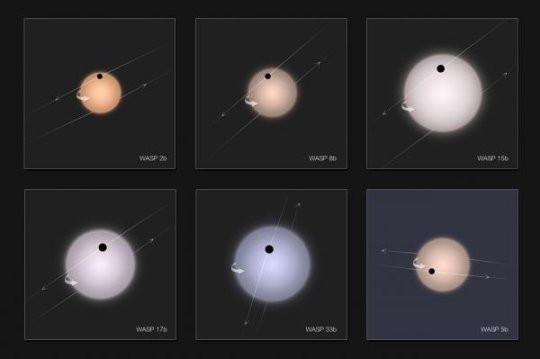Exoplanets with Retrograde Orbits Astonish Astronomers
According to conventional scientific wisdom, Earth is nothing special. Past discoveries demonstrate that our planet does not occupy a special location in space; plus, observations over the last two decades clearly show exoplanets orbiting other stars. In fact, the principle of mediocrity implies that astronomers should discover a wealth of planetary system similar to ours. Yet new exoplanet finds challenge the conventional wisdom by illustrating that most planetary systems don’t look anything like ours. So here are the latest examples.
Orbiting in the Wrong Direction
In our solar system all the planets orbit in the same direction the Sun rotates. Astronomers expected this feature—referred to as prograde motion—to be a characteristic of all exoplanets as well. (Meanwhile, six of the eight planets and all the large moons in the solar system exhibit prograde rotations—spinning on their axes in the same direction as the Sun’s rotations. Venus and Uranus are the only planets that exhibit retrograde rotation, or spinning in the opposite direction from the Sun’s rotation.) The discovery of nine new exoplanets announced at the recent Royal Astronomical Society meeting in Scotland astonished the astronomy community when it was revealed that six of those planets are now known to exhibit retrograde orbits. While suitable explanations exist for retrograde rotation, retrograde orbits were completely unexpected. Regardless, astronomers did work out a solution.
These retrograde planets belong to the “hot-Jupiter” category—Jupiter-sized planets that orbit close to their host star. Conventional explanations for the hot-Jupiters posit that through interactions with the gas/dust cloud surrounding the forming star, the planet migrates toward the star over the course of a few million years. This migration produces only prograde orbits aligned with the rotation axis of the star. Yet, as many as half the hot-Jupiters experience a misalignment of these two axes (see image below).The newly discovered retrograde orbits provided the necessary clue to explain the misalignment.

The explanation for this unexpected phenomenon requires changes in the orbital axis of the planet in question via multiple disturbances by other large planets and nearby stars. Subsequent tidal interactions with the host star then lead the planet into a circular orbit close to the star. This process occurs over tens to hundreds of millions of years, and its disruptive nature ensures that no Earth-like planets would form or remain in the system.
Forming in the Wrong Way
A team of astronomers found another way for uninhabitable, planet-like bodies to form. Using the Hubble Space Telescope, the team found a planet-like object orbiting a brown dwarf.1 Observations indicate that this binary system is bound to another brown dwarf with a planet-mass companion. Although two of these objects’ masses comparable to those of planets, all four of these objects likely formed at the same time as a single gas cloud collapsed and fragmented. In other words, even with planet-like masses, these objects formed like stars.
Our solar system stands in stark contrast. It formed only one star but with multiple Jupiter-class planets. The migration of these planets prepared the way for life on Earth and ensured asteroids and comets would not exterminate that life. These findings add to the body of evidence that Earth is unique in its capacity to support life.
Endnotes
- K. Todorov, K. L. Luhman, and K. K. McLeod, “Discovery of a Planetary-mass Companion to a Brown Dwarf in Taurus,” Astrophysical Journal Letters 714 (May 1, 2010): L84–L88.



